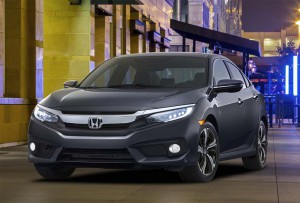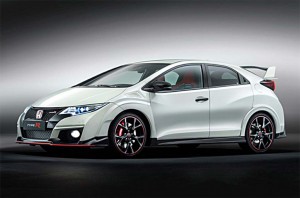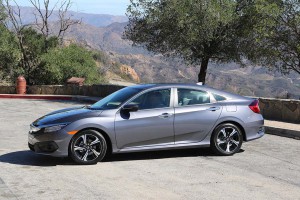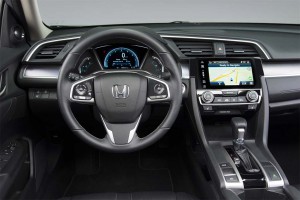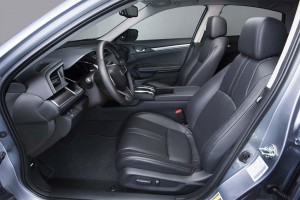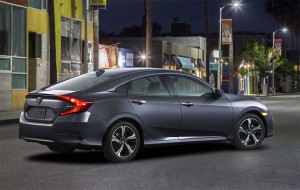Honda delivered one of the year’s biggest surprises when it pulled the wraps off an all-new version of the compact Civic at the New York Auto Show last April. The Honda Civic has been a perennial best-seller, but it was nonetheless a major surprise to see the Japanese maker unveil an all-new version barely four years after the current model made its debut.
If anything, Honda seems intent on proving that Civic’s ongoing success is more than a fluke. The outgoing, gen-nine model took some initial heat for its lackluster styling and less than inspiring on-road dynamics, forcing the maker to rush an “emergency refresh to market barely a year later to maintain Civic’s momentum.
The NY debut revealed a striking design loaded with new features meant to push the 2016 Honda Civic up against the boundaries of what might normally be considered “mainstream.” But to find out how it actually felt behind the wheel, we set off for Los Angele a few weeks ago to get a first drive of the new sedan.
Significantly, the maker’s U.S. design and engineering team played a lead role in the development of the 2016 Civic line, both the underlying platform and the sedan version’s styling. Meanwhile, Honda’s Ontario plant will serve as lead global factory.
(Honda to introduce new Civic Type R at Tokyo Motor Show. Click Here for a preview.)
Where early versions of the Civic might have put an emphasis on affordability, the targets Honda set for the R&D team this time had them benchmarking some of the best luxury products in the compact segment, such as the Audi A3. Among other things, they focused on four key areas to improve:
- Quietness;
- Performance;
- Handling and steering precision; and
- Ride refinement.
After spending a couple days with the new 2016 Honda Civic we’d say they delivered on all four of these goals – and more. The good news is that the next-gen Civic remains surprisingly affordable, the LX trim – including a 2.0-liter inline-four and six-speed manual – set to carry a base MSRP of just $19,475, including $835 for delivery. (A loaded Civic Touring model will get you just short of $30,000.)
Visually, “The new design looks into the future,” lead designer Guy Melville-Brown explained at the compact model’s debut, but it has “properties that harken back to the original Civic.”
The Coupe Concept we saw at New York’s Jacob Javits Center gave us a good hint of what was coming with the production model – or models, to be more precise, for we’ll see Honda roll out a wide array of variants over the next several years, from the high-volume Civic sedan to the U.S. version of the high-performance Civic Type R.
The sedan adopts a decidedly coupe-like shape, the roofline almost suggesting that of the sleek Audi A7. Up front, the sedan carries over many key details first seen on the concept coupe, including a bolder grille topped by a distinctive chromed crossbar. The grille is framed by cats-eye lamps, with LED running lights that almost look like twin Nike “swooshes.” Honda is now offering optional LED headlamps, a rarity in the segment, at least outside true luxury models.
The short trunk lid tapers into a subtle spoiler, itself framed by wraparound C-shaped taillamps.
What you won’t notice unless you slide underneath the new Civic is the full underbody pan, one of the many steps Honda has taken to reduce aerodynamic drag, it claims, by about 12%.
You will likely notice, at least subliminally, that the latest Honda compact has grown larger – in fact, it’s nearly as big as an Accord of just a few generations back. The 2016 Honda Civic measures 182.3 inches nose-to-tail, about 2.9 inches more than the outgoing model. While the wheelbase is 1.2 inches longer, the front overhang has been reduced 1.2 inches. And the new model sits a full two inches lower.
In fact, front passengers actually sit slightly lower than in an Audi TT. The good news is that the design allows them to slip inside comfortably. The flow of that windswept roofline makes for a bit tighter fit for backseat passengers. But while the headroom is a bit minimal there’s significantly more leg and shoulder room than before.
We’ve been disappointed to see, over the past decade or so, am obvious cost-cutting trend in Japanese interiors. That’s not apparent here. Honda has recognized that the cabin – where customers spend a good part of each day – is the last place to cut corners.
The new Civic isn’t quite up to the level of an Audi A3 or Mercedes-Benz C-Class, but it’s a notable step up from other mainstream compacts, such as the recently relaunched Toyota Corolla. Honda has added some nice touches, such as double-stitching on the instrument panel and lots of soft-touch materials. We also liked the two-tiered center storage and sliding cupholders.
Our single-biggest gripe? The touchscreen display that operates many key vehicle functions, including the audio system. The lack of knobs, especially for volume, is maddening. The touch-slider control tends to lag your finger, among other problems. And while the system is apparently intended to look high-tech, it comes across as cheap and gimmicky.
(Honda tops “Most Stolen Car” list. Click Here for the full story.)
Honda designer figured out they needed climate control buttons and knobs. We can only hope for an “emergency refresh” of the rest of the 2016 Civic’s controls.
One other odd shortfall: an undamped glovebox that can drop and bang your knees if you’re not careful opening it.
On the positive side, the reconfigurable LCD display that replaces the tach and speedometer is one of the simpler yet elegant executions of this technology we’ve seen.
Under the hood, the 2016 Honda Civic sedan will be offered with two engine options. There’s that base 2.0-liter making 155 horsepower and 138 pound-feet of torque. This naturally aspirated I-4 is the most powerful base engine Honda has ever offered.
Buyers also can opt for a 1.5-liter turbocharged four. This direct-injection package punches out 174 horsepower and 162 pound-feet of torque. And it does it with all but the most subtle amount of turbo lag and no readily apparent torque steer. We should note this is the first time and Honda Civic sold in the U.S., but for the sporty Si, have ever been outfitted with a turbo.
Both engines can be paired with either a six-speed manual or a CVT automatic. The stick is a blast to drive, especially with the turbo, giving you a level of involvement rarely found in the compact sedan segment these days. Driving up into the canyons and hills north of Los Angeles reminded us why so many Americans originally fell in love with the Civic – and gave us pangs of anticipation as we wait to see what other Civic variants, especially the Type R, will be like to drive.
As for the CVT, Honda engineers have programmed it to simulate shifting, especially under hard acceleration. It’s one of the best executions of the technology we’ve experienced, though it occasionally produced some of that undesirable rubber-banding effect.
If fuel economy is critical to your buying decision, the new Civic won’t disappoint, either. The 2.0-liter will give you an EPA-estimated 31 mpg City, 41 Highway and 35 Combined with the CVT. The turbo package actually does even better, squeezing out one extra mpg on the highway.
Getting back to those four key targets, Honda can check off performance. The interior, meanwhile, is unexpectedly quiet for a mainstream compact sedan.
Ride refinement gets another checkmark. The combination of a MacPherson front and Independent Multi-Link rear suspension system gives the new Civic a planted and predictable feel. There’s only modest body roll, even on sharp corners like those you’ll find on the Mulholland Highway, carving through the hills near Malibu.
The new Civic sedan has the sort of precise, responsive feel to its steering that you’d have expected out of a prior-generation Type R. Where some of its competitors are almost ponderous, jouncing around tight corners and rough roads, the new 2016 Honda Civic soaks up most bumps without toning down the thrill factor.
Another factor that helps is the use of new high-strength steels and the latest version of the Honda ACE body structure. The entire car is lighter, yet stiffer.
There’s also a payoff in terms of safety, Honda engineers claim. And while they’ve designed the new Civic to do a better job of protecting passengers in a crash, they’ve also loaded the sedan up with technologies designed to keep you out of harm’s way in the first place.
The new Civic is offered with the distinctive blind spot warning system first seen on the Honda Accord a couple years ago. It uses a camera mounted below the right sideview mirror, projecting an image on that center LCD console.
But the 2016 Civic gets a broad package of technologies dubbed the Honda Sensing Suite, including Land Keeping Assist, Road Departure Mitigation, Forward Collision Warning and more.
And there are plenty of comfort and convenience features, as well, including remote engine start, electronic brake hold, push-button start and, well, even on the web there’s a limit to how long a story can run on.
Which brings us to a good point to wrap things up. And with the 2016 Honda Civic Sedan, that’s not difficult. This is almost certain to become the new benchmark in the compact four-door market. The new Civic is attractive, roomy, well-equipped, fuel-efficient and fun to drive. Honda engineers have done such a good job we’re almost glad to find a few things to complain about.
The debut of the Civic last April came as a big surprise. It’ll be no surprise if the tenth-generation Honda Civic remains one of the best-selling vehicles on the U.S. market.
(Toyota planning to debut 3 concepts – and 1 cute robot – at 2015 Tokyo Motor Show. Click Herefor more.)

